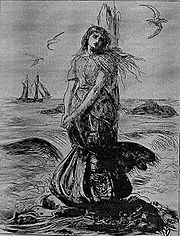
The Killing Time
Encyclopedia

Covenanter
The Covenanters were a Scottish Presbyterian movement that played an important part in the history of Scotland, and to a lesser extent in that of England and Ireland, during the 17th century...
movement, based largely in the south of the country and the government forces of Kings Charles II
Charles II of England
Charles II was monarch of the three kingdoms of England, Scotland, and Ireland.Charles II's father, King Charles I, was executed at Whitehall on 30 January 1649, at the climax of the English Civil War...
and James VII
James II of England
James II & VII was King of England and King of Ireland as James II and King of Scotland as James VII, from 6 February 1685. He was the last Catholic monarch to reign over the Kingdoms of England, Scotland, and Ireland...
. The period, roughly from 1680 to the Glorious Revolution
Glorious Revolution
The Glorious Revolution, also called the Revolution of 1688, is the overthrow of King James II of England by a union of English Parliamentarians with the Dutch stadtholder William III of Orange-Nassau...
of 1688, was subsequently called Killing Time by Robert Wodrow
Robert Wodrow
Robert Wodrow , Scottish historian, was born at Glasgow, being a son of James Wodrow, professor of divinity.-Biography:Ordered as in the text above:...
in his The History of the Sufferings of the Church of Scotland from the Restoration to the Revolution, published in 1721-1722. It is an important part of the martyr
Martyr
A martyr is somebody who suffers persecution and death for refusing to renounce, or accept, a belief or cause, usually religious.-Meaning:...
ology of the Church of Scotland.
Soon after the Restoration
English Restoration
The Restoration of the English monarchy began in 1660 when the English, Scottish and Irish monarchies were all restored under Charles II after the Interregnum that followed the Wars of the Three Kingdoms...
, episcopacy
Episcopal polity
Episcopal polity is a form of church governance that is hierarchical in structure with the chief authority over a local Christian church resting in a bishop...
was reintroduced into the Church of Scotland
Church of Scotland
The Church of Scotland, known informally by its Scots language name, the Kirk, is a Presbyterian church, decisively shaped by the Scottish Reformation....
, returning the situation to that existing prior to the expulsion of the bishops by the Glasgow General Assembly in 1638, and overthrowing the Presbyterian establishment favoured by the Covenanters. Church ministers were confronted with a stark choice: accept the new situation or lose their livings. Although most conformed, up to a third of the ministry refused, many abandoning their own parishes rather than waiting to be forced out by the government. Most of these vacancies were in the south-west of Scotland, an area particularly strong in its Covenanting sympathies. Some of the ministers also took to preaching in the open fields in conventicle
Conventicle
A conventicle is a small, unofficial and unofficiated meeting of laypeople, to discuss religious issues in a non-threatening, intimate manner. Philipp Jakob Spener called for such associations in his Pia Desideria, and they were the foundation of the German Evangelical Lutheran Pietist movement...
s, often attracting thousands of worshipers.
In the years that followed, the Stuart regime, worried about the possibility of disorder and rebellion and resentful of the Covenanters' having made their fighting for Charles II during the civil wars conditional upon the maintenance of Scottish Presbyterianism, attempted to stamp this movement out, with varying degrees of success. Fines were levied upon those who failed to attend government-approved churches, the death penalty was imposed for preaching at field conventicles, torture of suspects with the boot and thumbscrews became a tactic of first resort, thousands of highlanders (the 'Highland Host') were invited to plunder the Covenanting shires. These policies provoked armed rebellions in 1666 and 1679, which were quickly suppressed. This led to further dissent, such as the 1680 Sanquhar Declaration
Sanquhar Declaration
The Sanquhar Declaration is a speech read by Covenanter, Richard Cameron, accompanied by twenty armed men in the public square of Sanquhar, Scotland, in 1680, disavowing allegiance to Charles II and the government of Scotland, in the name of "true Protestant and Presbyterian interest", opposition...
, read in Sanquhar
Sanquhar
Sanquhar is a town on the River Nith in Dumfries and Galloway, Scotland. It lies north of Thornhill and west of Moffat. It is a Royal Burgh.Sanquhar is notable for its tiny post office , claimed to be the oldest working post office in the world...
by Reverend Richard Cameron
Richard Cameron
Richard Cameron may refer to:*Richard Cameron *Richard Cameron *Richard Cameron, member of Dutch electronic music duo Arling & Cameron...
, renouncing all allegiance to the crown.
In response to this new element of outright political sedition, the Scottish Privy Council
Privy Council of Scotland
The Privy Council of Scotland was a body that advised the King.In the range of its functions the council was often more important than the Estates in the running the country. Its registers include a wide range of material on the political, administrative, economic and social affairs of Scotland...
authorized extra-judicial field executions of those caught in arms or who refused to swear loyalty to the king. In 1685, John Brown
John Brown (Covenanter)
John Brown , also known as the Christian Carrier, was a Protestant Covenanter from Priesthill, a few miles from Muirkirk in Ayrshire, Scotland. He became a Presbyterian martyr in 1685....
was executed for the latter offence, while the 18 year old Margaret Wilson
Margaret Wilson (Scottish martyr)
Margaret Wilson was a young Scottish Covenanter, from Wigtown, Galloway in Scotland executed by drowning for refusing to swear an oath declaring the King as head of the church. She died on May 11, in 1685...
and 68 year old Margaret McLauchlan were drowned for refusing to renounce the Covenanters.

